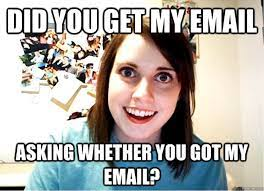Did you know that today’s buyer has already made 80% of the buying decision BEFORE the first sales call? This dramatic shift in buyer behaviour fundamentally changes how sales teams operate. It’s no longer enough to rely on first interactions or basic customer service; instead, a consistent and strategic sales follow-up is the key to staying relevant in the sales process.
At RedPandas, we’ve been coaching businesses for almost a decade on using effective sales techniques to increase sales close rates and shorten the sales cycle.
I’ve learned first hand that following up effectively can be the difference between closing a sale or losing a potential customer.
In this article, you’ll learn the importance of sales follow-ups and how to effectively follow up.
By the end of this article, you will have the tools you need to enhance your sales follow-up strategy, shorten your sales cycle and increase your sales close rate.
Why Sales Follow-ups Are So Important
The fruit is in the follow-up and chances are your sales team isn’t doing enough of them.
According to a study by Brevet, 80% of sales require an average of five follow-ups in order to close. Unfortunately, 44% of sales reps follow up with a prospect only once before giving up. After four follow-ups, 94% of salespeople have given up.
So let’s recap for a sec: We spend so much time, money and energy to get a lead but 94% of the time give up earlier than we should? It’s insane. Couple that with the fact the world of sales has evolved dramatically in recent years. The modern buyer, empowered by technology, access to information, and the ability to compare options with just a few clicks, is vastly different from buyers in the past.
You’re no longer simply interacting with an interested party – you’re engaging with an informed, discerning, and potentially skeptical individual.
They require more than a well-rehearsed sales pitch; they crave meaningful, personalised engagement and value-driven interactions – all drip-fed over a defined period.
In this ever-changing landscape, the traditional, transactional sales approach falls short.
One-and-done communications or generic, mass-produced emails will likely land you in the ignored or deleted category.
Instead, the modern buyer needs to feel heard, understood, and valued.
Sales follow-ups offer the perfect antidote to this change. They enable you to maintain an open dialogue with the potential buyer, allowing for conversations that extend beyond the initial sales pitch.
This creates an opportunity to demonstrate your genuine interest in solving their problems and meeting their needs, rather than merely pushing a product or service.
Through follow-ups, you’re able to present additional resources, provide solutions tailored to their specific needs, and most importantly build trust – all while ensuring that your brand remains at the top of their mind.
By building trust, you position yourself as an authoritative voice in your industry and become a trusted advisor in your potential client’s eyes, as opposed to a typical salesperson trying to close a deal.
And this is the key to success.
However, embracing this approach requires a mindset shift. Your role is not just to sell a product or service, but to act as a reliable guide, advisor, and partner to your prospective customers.
In the era of the changing buyer, sales follow-ups are no longer an optional afterthought. They are a crucial part of a comprehensive sales strategy, designed to cater to an informed, discerning, and demanding audience.
How to Do a Successful Sales Follow-up

A successful sales follow-up requires a mindset shift.
It is not about asking your customer where they’re at with the proposal, or whether they’ve had a chance to look over the contract.
Your sales follow-up is all about providing incremental value to your prospect and building trust, which you can do by providing education to your prospect. Educating your prospect reduces skepticism and increases trust which ultimately facilitates the sales process.
Why incremental? Well let me ask you this: Have you ever sent a lot of great information to a prospect only to have them ignore crucial bits of info and ask you anyway? If you’re in sales this is likely, and it tells you that you’re trying to dump too much on your prospects at a time.
Now let’s examine a few effective examples at different stages of the sales cycle.
Sales follow-up example
You’ve got the lead, your sales rep (or yourself) has chatted to them once and they’ve booked a time to speak with you for a longer discovery call.
You’ve got a week before the day of the call. This is a perfect opportunity to raise the stakes of your call and minimise the chances of “something coming up” last minute.
So, what can you do to engage your prospect before then?
Here’s an example of something you could send in an email:
“Hi, Harry! I’m looking forward to meeting with you next Wednesday. I’ve attached a buyer’s guide to read before our meeting that will answer all your questions you’ll likely have in advance to maximise and go over options you need to consider. This way, when we meet, we can make the most of our time together and focus on your specific needs. Chat soon.”
In this example, this (pre)follow-up establishes you as a trusted authority, which helps build trust and increases your chances of closing the deal.
Remember: A good sales follow-up should give the prospect a reason to engage, and it should also make the prospect feel valued.
We could actually make this example a little better. Take a look at this one:
“Hi, Harry! I’m looking forward to meeting with you next Wednesday. I’ve attached a buyer’s guide to read before our meeting that will answer all your questions in advance and go over the options you need to consider. This way, when we meet, we can make the most of our time together and focus on your specific needs. If you can’t read this before our meeting, let me know and I will reschedule for a better time. Can you confirm you’re able to do this before Wednesday?”
By making this small change and asking them to read the guide before your meeting, your follow-up becomes far more effective because it:
- Gives a definitive “why” reading the guide is important from the perspective of the buyer (it will answer your prospect’s questions so you can better use your time together)
- Shows your prospect that it’s important to read the guide before meeting with you (if they can’t get to it, you’re rescheduling).
- Asks for confirmation they will read the guide (so you can be sure when you go on that sales call, you’re not wasting your time).
- Most importantly, it gives you what we call “peer status”. You’re not just a salesperson trying to sell them anymore – you’re an authority and a trusted advisor.
Of course, you might not use a buyer’s guide, as there may be another piece of content that works better for your use case. The key is that content should have utility and value in helping them make a purchasing decision.
As you can tell, to make such powerful sales enablement content, marketing and sales need to be aligned. By aligning the two teams, you can create effective sales enablement content that can be used in sales follow-ups.
Good Sales Follow-up vs Bad Sales Follow-up
While follow-ups can be the difference between a closed deal and a lost opportunity, not all follow-ups are created equal.
The distinction between a good and a bad sales follow-up is crucial to your success, as each interaction impacts your relationship with the potential buyer.
You’ve already seen an example of a good sales follow-up in the previous section, so let’s take a look at what to avoid.
Example of a bad sales follow-up

“Hi [Prospect],
I hope this email finds you well. I’m writing to follow up on my previous email. Typically when I haven’t heard back from someone it means they are either really busy or aren’t interested. If you aren’t interested, do I have your permission to close your file? If you are still interested, what do you recommend as a next step? Thanks for your help”.
While you may think this sales follow-up is an effective approach, it actually sucks because it:
- Comes off as passive-aggressive, suggesting impatience or frustration
- Provides no added value to the prospective buyer, merely reiterating the previous communication
- Doesn’t offer any flexibility or understanding of the buyer’s circumstances
- Makes you appear as just another salesperson desperate to close a deal
- Not only that, but how many times have you received that same template!?
Here are some “don’ts” to keep in mind when crafting your sales follow-ups:
- Don’t make it about yourself; keep the focus on the buyer and their needs
- Don’t be impatient or aggressive; understand that buying decisions can take time
- Don’t forget to add value in each interaction; simply repeating what you’ve already communicated isn’t helpful
- Don’t neglect to confirm the next steps; ensuring the buyer understands what to do next is vital
- Don’t fail to position yourself as a trusted advisor and authority; avoid coming across as a salesperson merely trying to make a sale

By applying these principles, you can ensure your sales follow-ups are effective, meaningful, and tailored to meet the needs and expectations of the modern buyer.
Frequency: How many times should you follow up?
We touched on the study above by Brevet that showed 94% of salespeople give up after four follow-ups even though 80% of sales require five follow-ups.
When I’m consulting on Customer Journey Maps for clients, I ask Sales Leaders: What’s your follow-up touch point strategy?
If they don’t have an answer or industry-standard I recommend an 8-touch point strategy within 14 days. Yep, that’s right. That’s 8-touchpoints.
When you break it down, touchpoints add up pretty quickly as you can see in the excerpt of a Customer Journey map below:

It’s worth repeating here though: the key point is adding value, something new, at almost every touchpoint you have with your prospect. Different buyers will have different value drivers.
So, what’s next?
Remember, your prospect isn’t looking for another salesperson; they’re seeking a trusted advisor to help them solve a problem
It’s time for a fundamental shift in your sales follow-up strategy. Gone are the days when persistent and generic follow-ups were good enough.
Today’s buyer is well-informed, tech-savvy, and expects personalisation and value at every stage of their buying journey. Your follow-up strategy is no exception.
In essence, effective sales follow-ups are about building trust, showcasing your expertise, and making the prospect’s life easier. It’s about reading their minds, telling their story, and showing them why you’re uniquely positioned to solve their problems.
So, ask yourself this: are your sales follow-ups thoughtful, customer-centric, and valuable? Or are they rushed, generic, and self-serving? The difference between the two is the difference between a loyal customer and a lost prospect.
Now that you know how to close more deals with sales follow-ups, it might be beneficial to think about different types of value to provide in the sales process. Video happens to be one extremely effective type of content to share during the sales process to close more deals.
If you want to learn how to use video in the sales process to close more deals, check out this article.













